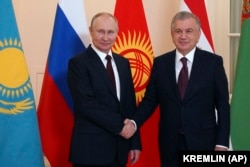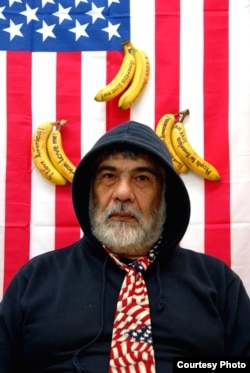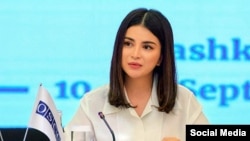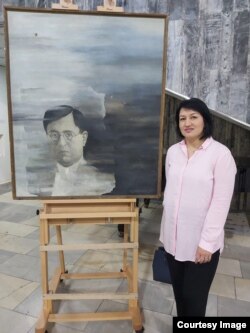The varieties masking the seven-meter vast, two-meter excessive summary portray float in a scene of violent chaos the place domed roofs, falling figures, and disembodied palms soar out of the canvas.
“When They Bombed Bukhara” is former dissident Uzbek artist Vyacheslav Akhunov’s 1987 depiction of the Bolsheviks’ 1920 bloody assault on the fabled Silk Highway citadel of the identical title — an air and floor operation that unseated the final emir of Bukhara and asserted communist management over the town.
Final week, the art work was supposed to finish its greater than three-decade exile from Uzbekistan to take its place at an exhibition within the state artwork museum in Tashkent.
However that didn’t occur and when Akhunov — who had introduced the portray to Uzbekistan from New York — visited the museum, he discovered his art work tightly guarded and wrapped in cellophane.
“They got here up with all kinds of excuses, like that the museum hadn’t had time to doc the portray earlier than the exhibition. However I knew that wasn’t the case as a result of one other portray of mine — the portrait of the poet Abdulhamid Chulpon — was included within the exhibition.”
Akhunov has his personal concept as to why plans for the exhibit all of the sudden modified.
“Most certainly there are some officers right here who’re sympathetic to Russia and didn’t need to irritate Moscow,” he instructed RFE/RL.
“Maybe they thought {that a} portray displaying how the Bolsheviks dropped bombs on a metropolis the place individuals had by no means seen airplanes earlier than would recall the present state of affairs with the battle in Ukraine,” Akhunov stated.
Fraught Histories
The obvious standoff over Akhunov’s portray comes at a time when debates over Russia’s colonial legacy in Central Asia are much more fraught than common because of Moscow’s unprovoked and bloody invasion of Ukraine, which started in February 2022.
Central Asian governments sometimes tread a troublesome line between accommodating fashionable calls for to readdress durations of historical past underneath Moscow’s yoke and aggravating a rustic that continues to be an necessary and typically capricious accomplice.
However it’s uncommon that Moscow overtly criticizes states that it considers its shut companions over their strategy to historic occasions, famous Sergei Abashin, a historian and anthropologist on the European College in St. Petersburg, who focuses on Central Asia.
“Clearly we’ve got a way more emotional Kremlin for the time being, with the battle in Ukraine, however they’re nonetheless considerably pragmatic, so I doubt any Russian official and even the embassy raised any objections about Akhunov’s portray,” Abashin instructed RFE/RL.
On the identical time, Abashin stated, it’s not out of the query {that a} high-up Uzbek official “determined to train warning” in relation to the art work, even though Uzbek President Shavkat Mirziyoev’s personal daughter, Saida Mirziyoeva, had performed a not insignificant position in facilitating Akhunov’s participation within the exhibition.
The primary half of final century is especially wealthy in contested historical past in Central Asia – from Tsarist crackdowns by means of the state-induced famine that killed greater than 1 million individuals in Kazakhstan within the Thirties and the Stalinist repression that worn out a few of Central Asia’s main lights.
The Bolsheviks’ seize of Bukhara, aided by resistance to the emir inside the town and strengthened with a shock and awe, air-and-ground assault that claimed hundreds of lives, is one other dramatic occasion from this era.
In an article marking a century for the reason that operation, information web site Eurasianet famous that the chief of the operation, Pink Military commander Mikhail Frunze, stays a villain in modern-day Bukhara.
“He’s recognized, notably amongst youthful generations, as the person whose bombing destroyed the town’s now-reconstructed Ark, the heaving fortress memorialized in numerous propaganda work and films,” Eurasianet wrote.
Akhunov recommended in feedback to RFE/RL that the brand new deputy director of the state museum, a Russian nationwide referred to as Mikhail Ovchinnikov, may need had a hand within the determination to not exhibit his portray.
Ovchinnikov beforehand labored within the Faberge Museum in St. Petersburg, Akhunov famous, which was based by Viktor Vekselberg, a Russian oligarch who was positioned underneath U.S. sanctions after the Kremlin’s February 2022 invasion.
The museum in Tashkent has launched no assertion on the matter.
However Akhunov stated the obvious censorship has led to a surge of curiosity in his portray.
“All people has been asking me how they will see it,” he stated, laughing.
Work With Tales
Regardless of the fact, each When They Bombed Bukhara and Akhunov’s portrait of the repressed Uzbek poet Abdulhamid Sulaymon-ughli Chulpon — which did seem within the exhibition final week — say one thing about modern-day Uzbekistan in addition to Moscow’s legacy within the area.
When They Bombed Bukhara was painted at a time when Mikhail Gorbachev’s coverage of glasnost (openness) was permitting extra scope for creative expression, and Akhunov was capable of show it in Tashkent – the place pro-communist artists criticized it strongly – earlier than taking it to London to exhibit it.
He then gave it to a relative who took it to the US, the place it remained till final month.
However, by the point Uzbekistan’s independence got here round, the portray wouldn’t have been welcome in Tashkent anyway.
That’s due to Akhunov’s shut friendship with Muhammad Salih, a preferred, opposition-minded author and poet who challenged Karimov in Uzbekistan’s first-ever presidential election.
Solih misplaced, alleging large ballot-rigging in Karimov’s favor, and was pressured out of Uzbekistan.
He would later be sentenced in absentia on terrorism prices that had been extensively seen as politically motivated.
Akhunov’s portrait of Chulpon, which he had gifted to Salih, disappeared after the election, having been embroiled in a scandal a number of years earlier.
“In 1988, Salih was elected chairman of the Union of Writers,” Akhunov recalled.
“One among his first actions in his new workplace was to take down the portrait of Lenin and exchange it with my portrait of Chulpon. Even at the moment [during glasnost] it was a tremendously daring factor to do. The communists had been furious.”
In 2009, Akhunov was reunited together with his outdated good friend in Istanbul, the place Salih was residing and the place Akhunov was exhibiting on the Istanbul Biennial.
When he returned house, Akhunov was knowledgeable by the authorities he would not be capable to journey overseas.
That journey ban remained in drive till Karimov’s loss of life and the arrival in energy of Uzbekistan’s present chief, Karimov’s reform-touting successor and protege, Mirziyoev.
The bid to search out the portrait of Chulpon and exhibit each works in Tashkent started a while in the past and was spearheaded by YUZUK, an Uzbek cultural collective based mostly in Germany.
Their efforts had been later supported by a basis chaired by 38-year-old Mirziyoeva, who holds a submit in her father’s administration and has used her political heft to advertise creative and cultural causes.
Ultimately, the portrait was present in February of this 12 months in Tashkent and handed over to YUZUK’s Dilbar Gaffarova in March.
Gaffarova instructed RFE/RL that the portrait of Chulpon had gone by means of at the very least seven homeowners for the reason that days when it had held on the wall on the Union of Writers in Tashkent.
“There was a gap on the canvas, a layer of thick mud, and one other layer of grime. I took the portray house to Akhunov earlier than it was handed over to the museum. He cleaned the portray with a weak answer,” Gaffarova stated.
Akhunov, in the meantime, instructed RFE/RL that, whereas he believes some constructive adjustments have occurred within the Mirziyoev period, the state of affairs surrounding the exhibit has added to his pessimism concerning the course the nation is touring in.
“Reforms are dealing with excessive problem. Corruption is huge. Resistance to vary is a big drawback,” he stated.




